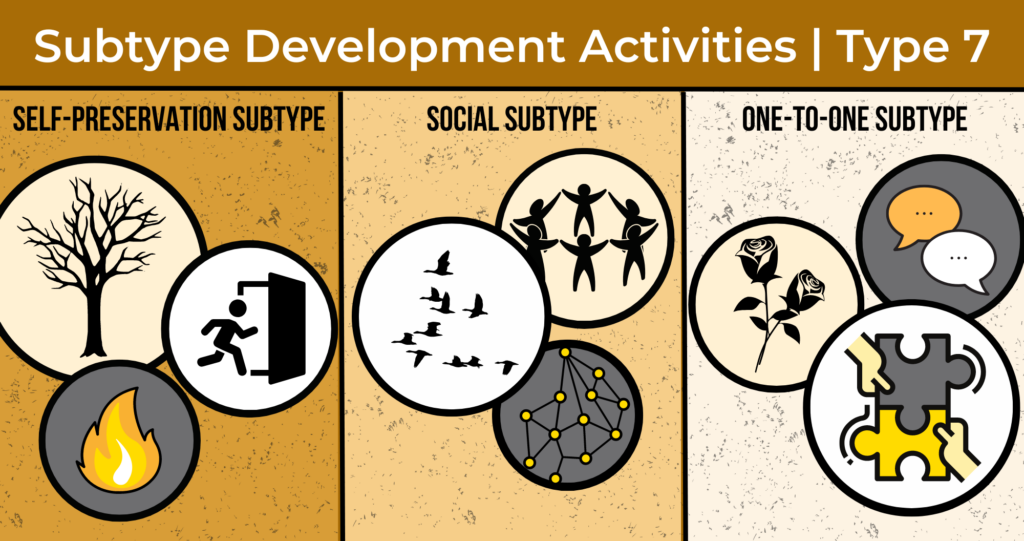There are three versions of each Enneagram type called subtypes: self-preserving subtype, social subtype and one-to-one subtype. Subtypes are formed when the emotional patterns or habits of our type, also called the type’s passion or vice, intersect and combine with one of the three basic human instincts, the instinct that is most activated within us: self-preservation instinct, social instinct or one-to-one instinct. We may have more than one activated instinct, so we could relate to two or even all three subtypes for our type.
Each instinct has specific focal areas. Individuals with that activated instinct, once it combines with the emotional pattern of our type, may move toward that instinctual area, away from that arena, or have ambivalence about that area. A way of understanding this is that the instincts by themselves are simply human and natural. However, when the activated instinct(s) combines with our type-based emotional pattern, the instinct then becomes distorted and, thus, less able to satisfy our natural needs in that instinctual area.
Here you can read about the passion or emotional habit of the type, a name for and a description of that subtype as it combines the emotional habit with that instinct, followed by one specific development idea that is particularly useful to people of that subtype. Please remember that we may have more than one active subtype, so the development activities for the additional subtype are also good for your development.
SEVENS
Emotional pattern of GLUTTONY
The insatiable thirst for new and constant stimulation via exciting people, ideas and experiences, thus enabling the avoidance of experiencing painful emotions, difficult situations and any sense of being limited or constrained
Self-preservation Seven subtypes
Self-Preservation Seven subtypes (“keepers of the castle”) create close networks of family, friends, and colleagues to keep themselves feeling stimulated and secure, as well as to generate new and interesting opportunities to pursue.
Self-preservation Seven subtype development
Notice how new opportunities and physical pleasure or satisfaction are so important to you; explore your anxiety and pain that lie underneath.
One way to explore your anxiety and pain that lie underneath:
Consider this idea: Assess the kinds of physical stimulation you crave the most. What are they? How often do they occur? What factors, internal or external, activate them? Next, every time you are about to pursue the particular kinds of physical stimulation you crave, pause and ask yourself what you are really feeling.
Social Seven subtypes
Social Seven subtypes (“sacrifice”) sacrifice their own needs for satisfaction and stimulation, at least temporarily, in service of the group or an important ideal by postponing their gratification, but they also want explicit recognition for their sacrifice and get their needs met shortly after their sacrifice.
Social Seven subtype development
Notice how you want to be acknowledged for your sacrifice and goodness; explore the feelings below your explanations and rationales for your sacrifice.
One way to explore the feelings below your explanations and rationales for your sacrifice:
Consider how important being explicitly thanked for your sacrifice really is to you. What happens when you don’t get this acknowledgment? What feelings arise in you? Explore these feelings and what lies beneath them. For example, if you get angry or resentful, why? If you feel anxious and fearful or perhaps sad and disappointed, what is underneath these emotions?
One-to-One Seven subtypes
One-to-One Seven subtypes (“suggestibility/fascination”) need to see the stark reality of the world in the most positive ways, as if they are using rose-colored glasses to embellish reality so they can live in a super-optimistic, dream-like state, and this is particularly true when it comes to relationships.
One-to-One Seven subtype development
Notice how you live in an idealized and embellished version of reality; ground yourself in unfiltered reality.
One way to ground yourself in unfiltered reality:
Have you ever been called or thought of yourself as naïve? Perhaps you are not naïve in all ways, but you may be in some ways. In particular, are you innocent and naïve because you primarily perceive the positive aspects of a situation without taking into consideration what might be neutral or even negative? Without perceiving reality as it is in its entirety, you may be suggestible or easily drawn to people, things and ideas that may not be good for you. Think of the ways in which you may be naïve or easily swayed. As you reflect on situations, what did you not let yourself see that was actually there? Understanding this can be helpful in your development and also save you from some of the big disappointments you may have already experienced.
These activities are excerpts from the new additions to the soon-available 3rd edition of The Enneagram Development Guide, with over 60 development activities for each Enneagram type.
Ginger Lapid-Bogda PhD, author of nine Enneagram books, is a speaker, consultant, trainer, and coach. She provides certification programs and training tools for business professionals around the world who want to bring the Enneagram into organizations with high-impact business applications. TheEnneagramInBusiness.com | ginger@theenneagraminbusiness.com


Comments are closed.